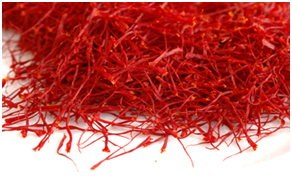
Frequently Asked Questions
![]() What should I look for in saffron?
What should I look for in saffron?
Firstly for an excellent quality ensure that the saffron has only bright red stigmas (red filaments) and no other part of saffron flower finds way into the pack.That means no extraneous waste, no style (yellow part). The style has no culinary value that means no aroma, flavour or colour, if left unattached to red stigmas, it adds dead weight to the saffron and the customer pays for it. Dryness (not beyond 4-5% ). Saffron filaments must be dry and brittle to touch.Any presence of moisture beyond 4-5% only adds to extra weight, lowers the quality and shortens the shelf life of the saffron. The aroma of the saffron should be fresh and intense and not musty.
![]() How is saffron quality measured?
How is saffron quality measured?
| Owing to high value of saffron, historically, it has always been subjected to adulteration by unscrupulous persons. Many consumers find it difficult to distinguish good quality from poor one until they notice the difference in coloring and flavoring powers. Therefore, it is important for consumers to understand the criteria for selecting good quality saffron. Scientifically the most important factors in evaluating the quality of saffron are crocin, picrocrocin and saffranal, which together produce the three things Chefs all around the world are looking for: |  |
Aroma (Saffranal), Flavour (Picrocrocin) and Color (Crocin). Pure red stigmas will always measure on the coloring scale. Saffron filaments should not leave any oil stain when its filaments are pressed between unglazed papers indicating the absence of added mineral/Vegetable oil. Ash should not be beyond 8%.
When added to water, the saffron filaments would leave golden yellow colour and elongate further giving out peculiar aroma and flavour indicating its purity. Any artificial filament would leave colour quickly and start disintegrating.
![]() How to use saffron ?
How to use saffron ?
| Our clients are largely professional chefs who work in some of the finest restaurant and hotel kitchens all over The world. However, it is just as important for us, as a saffron vendor, to make sure that every home cook, student chef, caterer, supermarket buyer and culinary academy not only buys the best saffron available anywhere but also knows how to use it properly to get the most value. So whether you use saffron once a year or several times a day, We have developed the following guidelines for you. |  |
It is very hard for the busy chef to remember to soak/infuse saffron threads before adding saffron to a recipe, so many times the threads are thrown straight into the boil; when you do that it is like throwing the saffron down the sink since saffron threads continue to release aroma, flavor and color for several hours.So always remember to soak saffron filaments in lukewarm water and give it adequate time to release the chemicals in saffron,i.e., crocin (color),picrocrocin (flavor), safranal (aroma).Once these three things are activated , you can directly add it to the recipe and savour its colour, flavor and aroma.

